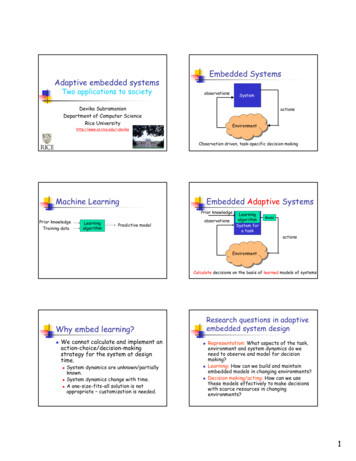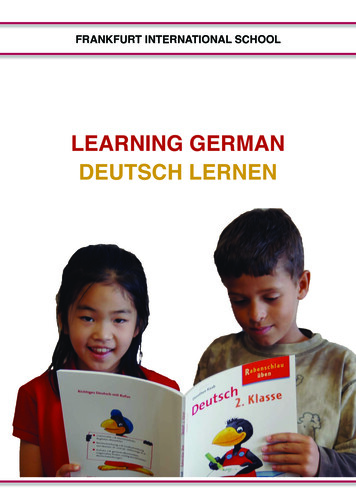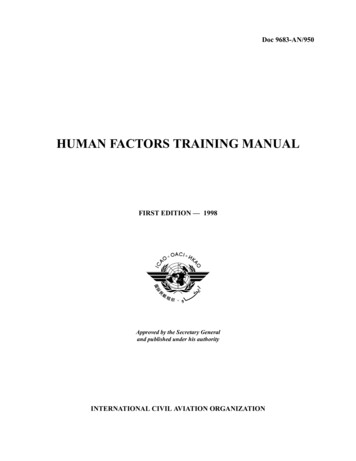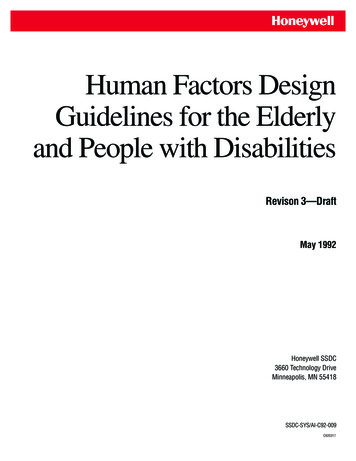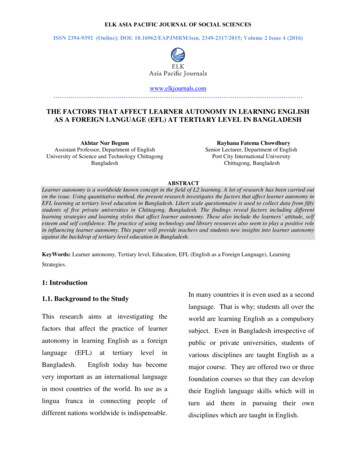
Transcription
ELK ASIA PACIFIC JOURNAL OF SOCIAL SCIENCESISSN 2394-9392 (Online); DOI: 10.16962/EAPJMRM/issn. 2349-2317/2015; Volume 2 Issue 4 (2016)www.elkjournals.com THE FACTORS THAT AFFECT LEARNER AUTONOMY IN LEARNING ENGLISHAS A FOREIGN LANGUAGE (EFL) AT TERTIARY LEVEL IN BANGLADESHAkhtar Nur BegumAssistant Professor, Department of EnglishUniversity of Science and Technology ChittagongBangladeshRayhana Fatema ChowdhurySenior Lecturer, Department of EnglishPort City International UniversityChittagong, BangladeshABSTRACTLearner autonomy is a worldwide known concept in the field of L2 learning. A lot of research has been carried outon the issue. Using quantitative method, the present research investigates the factors that affect learner autonomy inEFL learning at tertiary level education in Bangladesh. Likert scale questionnaire is used to collect data from fiftystudents of five private universities in Chittagong, Bangladesh. The findings reveal factors including differentlearning strategies and learning styles that affect learner autonomy. These also include the learners’ attitude, selfesteem and self confidence. The practice of using technology and library resources also seem to play a positive rolein influencing learner autonomy. This paper will provide teachers and students new insights into learner autonomyagainst the backdrop of tertiary level education in Bangladesh.KeyWords: Learner autonomy, Tertiary level, Education, EFL (English as a Foreign Language), LearningStrategies.1: IntroductionIn many countries it is even used as a second1.1. Background to the Studylanguage. That is why; students all over theThis research aims at investigating theworld are learning English as a compulsoryfactors that affect the practice of learnersubject. Even in Bangladesh irrespective ofautonomy in learning English as a foreignpublic or private universities, students oflanguageinvarious disciplines are taught English as aEnglish today has becomemajor course. They are offered two or threevery important as an international languagefoundation courses so that they can developin most countries of the world. Its use as atheir English language skills which will inlingua franca in connecting people ofturn aid them in pursuing their owndifferent nations worldwide is indispensable.disciplines which are taught in English.(EFL)Bangladesh.attertiarylevel
ELK ASIA PACIFIC JOURNAL OF SOCIAL SCIENCESISSN 2349-2317 (Online); DOI: 10.16962/EAPJMRM/issn. 2349-2317/2015; Volume 2 Issue 4 (2016)In most cases English is taught byeven hesitate to express any sort of problemsteachers at tertiary level in Bangladesh usingthey face. They are reluctant to approachtraditional method of delivering classroomtheir teachers in case they may be rejected.lectures. They teach grammar using theAs a result, learners feel demotivated.Grammar Translation Method (GTM) inLearners realize that they will not beteacher-oriented classrooms. In Bangladesh,benefitted if they remain passive. They wishteaching is generally viewed as “teacher-to learn English without depending oncentered” (Choudhury, cited in Bashir, 2014,teachers. They feel more at ease if they canp.171). Teachers use the deductive methodshare their problems in learning Englishof teaching and they provide lectures usingwith their peers. They prefer to be active andBengali and English blended together. Theyto take charge of their own study and soare the only active speakers, whereas, thelearner autonomy should be promoted inlearners in EFL classrooms are passiveEFL classrooms at tertiary levels.listeners. Most of the time teachers supplystudentsandreceived a great interest from researchers allheavilyaround the world with a great deal of thedependent on teachers and so they fail toresearch originating in Europe and Asiadevelop their skills in English. They are not(Nguyen, 2014) Nguyen also states that asable to utilize their creative faculty inresearchersdeveloping the receptive and productiveautonomy from different perspectives, thereskills to express themselves in English.existsMost of the time, they suffer from notesLearner autonomy in EFL rneronlearnershyness and fear of making errors. They1.1.1. Learner AutonomyHolec (1981, cited in Bashir, 2014, p.172)defines the term autonomy as ‘the ability totake charge of one’s own learning.’ Againthe development of learner autonomy inforeign language classrooms can contributeto achieving optimal success in languagelearning (Little, 2004a cited in Bashir, 2014,p.171).Learner autonomy ensures a‘learner’s freedom as an individual one’ andit goes ‘against old, traditional and teachercentred practice of language teaching’(Jamila, 2013, p.31). Autonomous learningencouragesEFLlearnerstotake
ELK ASIA PACIFIC JOURNAL OF SOCIAL SCIENCESISSN 2349-2317 (Online); DOI: 10.16962/EAPJMRM/issn. 2349-2317/2015; Volume 2 Issue 4 (2016)responsibility for their own learning and thisown language learning and every learneralso helps them build up their cognition andgives himself immense importance.self confidence. Learners can monitor their1.1.2. English as a Foreign Languageinstruction in education nor as a language ofcommunication (eg in government, business or(EFL)Using English as a foreign language means ‘theindustry) within the country’ (Richards, Plattrole of English in countries where it is taught asand Weber, 1987, p.93). This research is abouta subject in schools but not as medium oflearning EFL at tertiary level in Bangladesh.1.2 Statement of Problemteacher is to transmit knowledge to herLearner autonomy has been commonlystudentspractised around the world from the end ofstudents to become autonomous in theirthe twentieth century and it has beenlearning. It is demotivating for learners tosuccessfully used in‘teaching secondfind that even after studying English forlanguage worldwide’ (Jamila, 2013, p.29).fifteen years (from play group level up toIn Bangladesh the teacher-led approach isclass 12), they fail to study on their ownstill a tradition, that is, the main task of awithout depending on teachers’ support.ratherthanencouragingthe1.3 Research ContextThe above section provides a brief view ofdescribes the rationale for conducting suchthe issues related to learner autonomy andresearch and how to promote learnerthe need for undertaking a research on theautonomy in learning EFL in Bangladeshifactors that affect learner autonomy intertiary level education.learning EFL in Bangladesh.This study1.4 Education Structure of Bangladesh
ELK ASIA PACIFIC JOURNAL OF SOCIAL SCIENCESISSN 2349-2317 (Online); DOI: 10.16962/EAPJMRM/issn. 2349-2317/2015; Volume 2 Issue 4 (2016)Figure 1: Education structure of nBureauandofStatisticsvocational educational and professionaleducation.General education consists of(BANBEIS)1, the present education systemprimary level, secondary level and tertiaryof Bangladesh consists of three major stageslevel. Tertiary level is comprised of 2 – 6namely, primary, secondary and tertiaryyears of schooling at colleges. Universitieseducation. Primary level institutions impartoffer graduate and post-graduate degreeprimaryjuniorlevel education The University Grantssecondary/secondary and higher secondaryCommission (UGC)2 is the apex body of alllevelsecondarythe affiliate public, private and internationalDegree pass, degree honours,universities of Bangladesh. It provides fundmasters and other higher level institutionsfor ‘Government funded universities’ ofimpart tertiary on.impartThe education system is categorized intoIt maintains the autonomousnature of universities. It also ensures thetwo streams: primary education (grade I –availabilityV) and post primary education. The postBangladesh.primary education is further classified intoobtain permission from UGC before theyfour types in terms of curriculum: generaloperate.ducation, madrasah education, technical-with universities directly but has to deal1http://www.banbeis.gov.bd/es bd.htmofhighereducationinPrivate universities mustThe Government does not deal
ELK ASIA PACIFIC JOURNAL OF SOCIAL SCIENCESISSN 2349-2317 (Online); DOI: 10.16962/EAPJMRM/issn. 2349-2317/2015; Volume 2 Issue 4 (2016)with UGC which in turn deals with variouslearning English as a foreign languageuniversities.UGC offers scholarships to(EFL) at tertiary level in Bangladesh. Theoutstanding students, funds researches andfindings of this research will hopefullyorganizes seminars.encourage EFL learners to be able toThe UGC of Bangladesh was establishedpractice learner autonomy so as to boost upunder the President order (P.O.) No. 10 oftheir confidence and learning aptitude.1973 which was deemed to have come intowillforce with effect from 16 December, 1972autonomy among the learners so as toResearch Aim and Significancefacilitate their English language learning.alsoallowteacherstoItdevelopThe aim of this research is to investigate thefactors that affect learner autonomy in2: Literature Reviewdeveloping learner theory followed by theThis chapter reviews literature on definitiondescription of the learning strategies thatand topics relating to learner autonomy.learners practise for self-directed learning inSection 2.1 gives definition of learnersection 2.4. This includes the cognitive andautonomy from different sources. Sectionthe metacognitive strategies. The social-2.2 discusses the different learning theoriespsychologicalsuch as positivism, constructivism and themotivation are discussed elaborately incriticallearnersection 2.5. Finally, section 2.6 suggestsautonomy within EFL classrooms. Sectionsome ways in which learner autonomy may2.3be developed within EFL lvedinfactorsi.e.attitudeand2.1 Learner Autonomy (LA)refers to how students reflect on theirAs indicated in (chapter 1) a number oflearning and how they are able to realizedefinitions of learner autonomy generallywhenexist in education, particularly in EFL.opportunities.Following the definition given by Holec inteaching comprises of many more terms1981, a number of other definitions forsynonymous to autonomy such as ‘languagelearner autonomy were used.Wendenawareness’ (Lier, 1996, cited inJamila,(1999, cited in Nguyen, 2014,) indicated thep.31), ‘self-direction’ (Candy, 1991, cited inimportance of metacognitive awarenessJamila, p.31) which serve the purposewhen she claimed that, the learner autonomyclosely.theyhaveeffectivelearningThe field of languageIf we review some of these
ELK ASIA PACIFIC JOURNAL OF SOCIAL SCIENCESISSN 2349-2317 (Online); DOI: 10.16962/EAPJMRM/issn. 2349-2317/2015; Volume 2 Issue 4 (2016)definitions we may be able to understandcited in Bashir, 2014.p.172).closely what learner autonomy means andautonomy enables an EFL learner to learn inaims at. Learners in EFL classrooms area self-directed way.dependent on teachers of learning and this isimposed for the learners but rather achieved.demotivating in their English learningThey are not controlled by anyone elseatmosphere.However, do these studentsrather they feel enthusiastic about takingreally prefer depending on their teachers forresponsibility of their own learning. In thistheir learning? Harmer (2007, p.394) notesway they are able to find out and solve theirthat a language teacher may be good butown problems in EFL learning by exploringstudents will face difficulty ‘unless they aimtheir hidden potentials and interests. Theto learn outside as well as during class time.’teacher plays the role of facilitator andHe also adds that ‘students need to becreatesmotivated by teachers to develop their ownenvironment for the learners. Gould (2013)learning strategies,’Thus, they becomestates that learner autonomy enables learnersautonomous learners, that is, they are ‘thenot only to take control and responsibility ofdoers rather than the recipients of learningtheir own learning but also makes studentsaction.’ Edge and Wharton opine that evencapable of self – direction and are able tothough ‘classrooms provide a relatively safedevelop an independent, pro-active approachenvironment for language discourse; theto their studies.major goal for learners is to be able tostudents are self – reliant have the potentialtransfer what they have learnt to the worldto learn better than passive learners.outside’ (Tomlinson, p.296).According to Littlewood (1996, p.97),‘autonomy is the learner’s ability andwillingness to make choices independently.’In order to have successful learning, learnersshould be reflectively engaged in planning,aSo, learnerThis learning is notcongenialandproductiveShe believes that suchFrom the discussion so far, s learners (Jamila, 2013): Learners set their objectives andare aware of their goals. Theyutilizeandexperiencemonitoring and evaluating their learning infreedom in selecting materialsthe class.according to their objectives.The skills and knowledge thelearners acquire in the classroom can beutilised in the world outside (Little, 2000,
ELK ASIA PACIFIC JOURNAL OF SOCIAL SCIENCESISSN 2349-2317 (Online); DOI: 10.16962/EAPJMRM/issn. 2349-2317/2015; Volume 2 Issue 4 (2016) They have insights into theirResearchers understand that in order tolearning styles and can choosebecome autonomous, a learner has to worktheir own strategies.to achieve autonomy and that autonomy They can assess themselves. Learnersareguidedcomesandfacilitated by teachers in tionally1991,citedinThanasoulas, 2000).promoteslearning easily.2.2 Learning Theories and Learnerhow they are linked to learner autonomyAutonomywill be discussed.In this section three important approacheswhich influence knowledge and learning and2.2.1 PositivismAccording to Benson & Voller (cited inpassive learners. This view is contrary toThanasoulas, 2000), Teachers believe thatlearner autonomy. So, positivism inhibitsknowledge reflect objective reality.So,learners in EFL classes and demotivateslearning is the transmission of knowledgethem from setting objectives to achieve theirfrom one individual to another. Positivismgoals. This view of positivism is opposed tofavourstraditionalthe development of learner autonomy inclassrooms where teachers are considered aswhich learners are free to set their objectivessuppliers of knowledge and students arein a teacher–student friendly environment.2.2.2 Constructivismmeaning to, or construe , the perplexingConstructivism learning theory is based onmaelstrom of events and ideas in which theythe principle that students build knowledgefind themselves caught up.’ It runs counterbased upon existing ideas and it avoidsto positivism in which students receivedirect instruction. As Candy (1991,p.254)knowledge passively. The activities areobserves, ‘.one of the central tenets ofinteractive and student–centred rather thanconstructivism is that individuals try to givelesson – centred. The teacher is seen as ateachercentred
ELK ASIA PACIFIC JOURNAL OF SOCIAL SCIENCESISSN 2349-2317 (Online); DOI: 10.16962/EAPJMRM/issn. 2349-2317/2015; Volume 2 Issue 4 (2016)guide to learning and helps each learner tothis approach makes EFL learners capable ofcreate knowledge based on information thatself-direction and enables them to play theirthey get from their world around them. So,role as active learners of knowledge.Thanasoulas, 2000).They also state that2.2.3 Critical Theorycritical theory is all about power andCritical theory agrees with constructivism inpolitics. It deals with power relations andthe sense that knowledge is not discoveredpower dominance.or learned but it is constructed (Thanasoulas,powerful groups in society which bring2000).about social change. This helps learners toAccording to critical pletingthatIt focuses on certainrealize the social context in which they learnrealityindependently, banish all sorts of falseexpressing the interests of different socialbeliefs, and can be thought of as authors ofgroups (Benson & Voller, 1997, cited intheir own worlds.2.3 Issues Involved in Developing LearnerEFL learners’ enthusiasm into practicingAutonomylearner autonomy. The learner and teacherSo far in this study, main features of learnerinteraction is essential for the learnerautonomy have been discussed.autonomy to be implemented.It isHowever,comprehended that autonomy is not aautonomy being a new concept to someproduct but as process. It is achieved byteachers, they fail to understand it. They arefulfilling certain conditions such as learningill – prepared and reluctant to allow studentsstrategies including the cognitive and theto take over their own learning. Only aftermetacognitive, motivation, attitudes, beliefsunderstandingand modes, awareness about the languageautonomy, teachers can motivate students toand the self and meta - language, that is, adevelop learning strategies through learnerlanguage analyzing another language. Onetraining in the classroom by raising theconceptoflearnerThey should realize it is worthautonomy is the role of a teacher. Learnerassimilating learner autonomy into theirautonomy cannot be achieved withoutpedagogy.teacher support. Teacher helps gear up the
ELK ASIA PACIFIC JOURNAL OF SOCIAL SCIENCESISSN 2349-2317 (Online); DOI: 10.16962/EAPJMRM/issn. 2349-2317/2015; Volume 2 Issue 4 (2016)2.4 Learning Strategieslearner to make language learning moreLearner autonomy involves students using asuccessful,number of learning strategies which they are(Oxford, 1990 cited in Cook, 2008). Cookcapable of applying flexibly in different(2008) notes that it is a choice a learnercontexts.O’Malley and Chamot (1990,makes in SLA and which affects his l2cited in Cook, 2008) carried out an extensivelearning. Based on this concept of learnerresearchautonomy this study discusses two mainaccordingtowhichlearningstrategies is based on cognitive psychology.self–directedandenjoyablelearning strategies.Learning strategies are steps taken by the Use of repetition for imitation of2.4.1 Cognitive StrategiesThe term ‘cognitive strategies’ refers to theuse of mind (cognition) in languagelearning, that is, it involves ‘using all yourspeech. Practiceresourcingsuchasdictionaries for information.mental processes’ (Cook, 2008, p.116). Using one’s mother tongue forO’Malley and Chamot (1990, cited in Cook,translating so as to be able to2008) say that cognitive strategies involveunderstand and produce L2conscious ways of tackling learning, such asnote-taking, resourcing (using ing new information to old).They Note – taking of lectures delivered inL2. Deduction, that is to know how toapply L2 rules.further add that strategies help enhance the Using contextualization to insert alearners learning by operating and directlyword or a phrase in a meaningfulmanipulating incoming information.sequence.Thecognitive strategies increase the efficiency Transfer, that is to remember factswith which a learner learns to do a task.and sequences in L2 by utilizingAccordinginformation acquired in L1.toCook(1993,citedinThanasoulas, 2000), learners may use thefollowing cognitive strategies: Use of inference to match anunfamiliar word with a familiarword.
ELK ASIA PACIFIC JOURNAL OF SOCIAL SCIENCESISSN 2349-2317 (Online); DOI: 10.16962/EAPJMRM/issn. 2349-2317/2015; Volume 2 Issue 4 (2016)2.4.2 Metacognitive Strategiesone’s learning. It also involves evaluatingIt is an indirect strategy which involveshow well one has done (O’Malley and‘organizing and evaluating one’s knowledgeChamot, 1990, cited in Cook, 2008).for e.g. by preparing in advance what isstrategy of planning includes the setting ofgoing to come up in the next class’ (Cook,goals and selecting appropriate cognitive2008, p.116).strategy to achieve those goals (Wenden,Metacognitive strategiesconcern with planning, thinking monitoring1998, cited in Thanasoulas, 2000)).They2.5 Social and Psychological Factors:Self- esteem, Motivation and s.Coppersmith (1967, pp.4-5), states thatself - esteem is ‘a personal judgement ofAttitudesIfTheiscommunication,thenworthiness that is expressed in attitudes thatsuccessful EFL learning depends on somethe individual holds towards himself’.social and psychological factors of learningAccording to him learners having goodand teaching so as to establish meaningfulfeelings about themselves are sure toEFL in the classroom. Students’ learningsucceed.activities depends on their learner awarenessAttitude is defined by Wenden (1998,as learners, their learning context, thep.52) as ‘learned motivations, valued beliefs,language to be learnt, their learning stylesevaluations, what one believes is acceptable,and strategies and their desire to learn.or responses oriented towards approachingShumann (1978, cited in Thanasoulas, 2000)or avoiding’.and Larsen – Freeman and Long (1991, citedvitalin Thanasoulas) view that social andattitudes and beliefs about themselves inpsychological factors describe in a betterlearning process and their ability to learn.way how students react to the learningStudents’ beliefs about themselves have anprocesses. These factors include learners’impact on their performance in the EFLself – esteem, attitudes and motivation.classrooms. For instance if the students areTwo types of attitudes areaccordingtoWenden;learners’convinced that they do not possess enoughLearners have a clear idea about the purposeaptitude for language learning they may notof learning the language, the areas of theirmake any effort to learn the language. Inproblems and improvement in that language.other words, beliefs can become unfortunate
ELK ASIA PACIFIC JOURNAL OF SOCIAL SCIENCESISSN 2349-2317 (Online); DOI: 10.16962/EAPJMRM/issn. 2349-2317/2015; Volume 2 Issue 4 (2016)in fostering learner autonomy.TeachersMotivation according to Dornyei (1998,have a role in assessing whether student’scited in Thanasoulas, 2000) is the mainbeliefs might have a negative impact onstimulatinglearning.Motivation is crucial as it enhances theSo, learners need to actorinL2learning.desire of a learner in EFL classroom.Motivation makes a learner feel optimisticabout her success in EFL learning.2.6WaysofDevelopingLearnerlanguage courses which ‘reflect the learnersAutonomygoals in its language, task and strategies.’There are different ways of developingThe course tasks should be authentic relatedlearner autonomy. Cotterall, (2000, cited into the real world and ‘promote reflection onHarmer, p.395) suggests that in order tolearning.’promote learner autonomy and create learnerdeveloping learner autonomy are:Some common ways ofawareness, learners should be assigned2.6.1 Journalspractice and helps to improve the students’According to Harmer (2007, p.400) journalgeneral writing skills and enable them towriting provides students ‘ good writingexpress feelings more freely.’2.6.2 Self –reportsquestionnairesWenden (1998) states that self- reportinformation about the learners’ feelings,writing help learners to introspect on theirskills and the problems she or he faces. Bylearning. She also adds that self – reportswriting self –reports learners can becomeprovidestrategiesaware of their learning strategies and alsolearners use at the time of report. Wendencan evaluate their goals and techniques forcategorizes self- report into two types: semilearning.informationonthebothofwhichextract– structured interviews and structured2.6.3 Note – taking and DiariesEFL learners at tertiary level study coursesin which lectures are delivered in English
ELK ASIA PACIFIC JOURNAL OF SOCIAL SCIENCESISSN 2349-2317 (Online); DOI: 10.16962/EAPJMRM/issn. 2349-2317/2015; Volume 2 Issue 4 (2016)and for these they need to take notes.initiatives in learning because people whoHarmer (2007, p.399) observes ‘the purposetake the initiative learn more than those whoof this activity is to get students to select await passively for teachers to teach themstrategy so that they can take responsibility(Knowles, cited in Bashir, 2014, p.176.).for their own note – taking method’. SomeSo, teacher-student relationship is vital.learners take copious notes, while othersFrom the above literature review, it cannote down a few points. Diaries on the otherbe observed that learner autonomy ishand, help students to plan, monitor andpracticed worldwide. At present, it enjoysevaluate their learning, identifying anyhigh demand and is considered to beproblems they run into and suggestingimmensely fruitful. Hence, it is important tosolutions (Thanasoulas, 2000).investigate the scope of implementingAgain,though the notion of learner independenceLearner autonomy in Bangladesh.does not follow tradition where the teacherstudy investigates the factors that affect theis director of learning, yet the teacher doeslearner autonomy in EFL classrooms atnotauthority.tertiary level in Bangladesh and alsoTeachers can help students to develophopefully it will give rise to further scopeslearning strategies through learner trainingfor other researchers to work with learnerin many ways. Learners should also takeautonomy.completelyrelinquishand population in section 3.2.ThisThe3: Research Methodologysubsequent sections describe the method inEarlier, chapter two outlined the existingwhich this research was conducted in sectionresearchlearner3.3 the instruments that were employed inautonomy in learning English as a foreignsection 3.4 including the discussion of thelanguage and it mainly focused on thedata collection in section3.5 and the analysisdifferent theories and other issues includingmethods that were used in section elopautonomy among EFL learners.learnerChapterthree provides the research questions insection 3.1 and description of the sampling3.1 Research questionsthepotentialproblemslimitations are described in section3.7.and
ELK ASIA PACIFIC JOURNAL OF SOCIAL SCIENCESISSN 2349-2317 (Online); DOI: 10.16962/EAPJMRM/issn. 2349-2317/2015; Volume 2 Issue 4 (2016)The primary focus of this study is on1. How autonomous are the tertiarylearners and the factors that affect learnerlevel EFL learners in Bangladesh?autonomy in EFL learning in Bangladesh2. What are the factors that affectand the research question for this study are:learner autonomy at tertiary level inBangladesh?3.2 Sampling and population(USTC), Southern University BangladeshThe sample population in this study(SUB), International Islamic Universitycomprises of fifty undergraduate studentsChittagong (IIUC), Port City Internationalfrom first to eighth semesters of differentUniversityfaculties studying in five universities ofInformationBangladesh.(UITS).variousThese students belong eThe participants for this study are chosenofusing random sampling, that is, samples areBusiness Administration (BBA), Pharmacy,selected randomly. Selection is based onBSc in Textiles and Economics and Bankingchance and it is unbiased. Conclusions canand have taken English as the prerequisitebe made pertaining to the population fromcourseforthe results obtained from the sample,are(Dornyei, 2007). 50 participants are chosenselected for the study are University ofthrough random sampling for world. Quantitative research is a very useful3.3. Adopted Methodology with Rationaleresearch methodology because it is less timeSince the present study aims to respond toconsuming and less costly because the datathe research questions of a quantitativecan be analyzed using statistical computernature, quantitative method is used tosoftware. This inquiry is rigorous, focusedexplore the issue.and tightly controlled, involving precisemeasurement and producing reliable andQuantitative research is a formal objectivereplicable data that is generalizable to otherand systematic process where numericalcontexts (Dornyei, 2007).data is used to collect information about thequantitative method in this research, it isBy employing
ELK ASIA PACIFIC JOURNAL OF SOCIAL SCIENCESISSN 2349-2317 (Online); DOI: 10.16962/EAPJMRM/issn. 2349-2317/2015; Volume 2 Issue 4 (2016)expected that the result that would emergewould be acceptable to a large audience.3.4 InstrumentsThe instrument, a written questionnaire isthey are often designed for statisticalused to collect a quantitative data. Aanalysis of the responses this is not alwaysquestionnaire is a research instrumentthe case.consisting of a series of questions and otherThe following table is an overview of theprompts for the purpose of gatheringrelation between research questions andinformation from respondents. Althoughitems in the questionnaire:Table 1: Relation between research questions and items in the questionnaireResearch questionsRelated items in the questionnaire1) How autonomous are a) I cannot learn English with/without my teacher/myself.the tertiary level EFL b)I should learn English within my institution/athome/outside the class.learners in Bangladesh?c) I can evaluate my learning/plan my learning.d)Self-study gives me confidence/ interest.e) I do not understand when I read alone.f) Ican organise my learning materials with/ without teachershelp.g) I can plan my learning schedule.2) What are the factorsa) I use the resources available at the university library.that affecting learnerb) I use computers/audio-visual equipment for learningEnglish activities.c) I do not know how to use technology/online learningactivities for learning English.autonomy at tertiarylevel in
EFL learning at tertiary level education in Bangladesh. Likert scale questionnaire is used to collect data from fifty students of five private universities in Chittagong, Bangladesh. The findings reveal factors including different learning strategies and learning styles that affect learner

